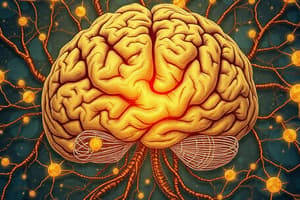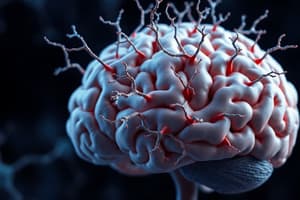Podcast
Questions and Answers
During what time period does neuronal differentiation mostly occur?
During what time period does neuronal differentiation mostly occur?
- First 5 months
- Postnatally
- During birth
- 4-9 months (correct)
What is the function of glial cells?
What is the function of glial cells?
- All of the above (correct)
- Response to injury only
- Structural support only
- Homeostasis only
What is the result of failure of caudal neural tube closure?
What is the result of failure of caudal neural tube closure?
- None of the above
- Spina bifida (correct)
- Both anencephaly and spina bifida
- Anencephaly
Flashcards are hidden until you start studying
Study Notes
Development of the Brain and Neurons
- The brain has around 100 billion neurons, which make up 40-50% of the brain and have diverse shapes, sizes, and neurotransmitters.
- Neuronal proliferation occurs mostly in the first 5 months, while neuronal differentiation occurs mostly in 4-9 months. Neuronal connections continue to form postnatally.
- Glial cells, derived from neuronal crest cells, have various functions such as homeostasis, structural support, myelination of axons, and response to injury.
- The trilaminar embryo has three germ layers, and neural plate buckles down to form a groove, which forms the neural tube and neural crest cells that form the PNS.
- Failure of rostral neural tube closure results in anencephaly, while failure of caudal neural tube closure results in spina bifida.
- The brainstem has a diamond-shaped cavity with a sulcus limitans dividing it into dorsal sensory and ventral motor regions, and cranial nerve ganglia are associated with sensory function.
- The telencephalon forms the corpus callosum, basal ganglia, thalamus, and hypothalamus, while the lamina terminalis is the rostral tip of the neural tube.
- Sulci and gyri form as more cells form, and the insula cortex is overgrown by the temporal, parietal, and frontal lobes.
- Electrically active neurons allow rapid and reliable long-distance communication, and myelination occurs mostly postnatally.
- Astrocytes contribute to the blood-brain barrier and reuptake of neurotransmitters, while microglia are the resident immune cells of the CNS.
- The mesencephalon has colliculi, and the pons connects the brainstem to the cerebellum.
- The ventricles are remnants of the neural tube, and the cerebellar cortex, amygdala, and dorsal thalamus are parts of the prosencephalon.
Studying That Suits You
Use AI to generate personalized quizzes and flashcards to suit your learning preferences.




